
Journal of Magnetics
Scope & Guideline
Elevating Knowledge in the Dynamic Field of Magnetics
Introduction
Aims and Scopes
- Magnetic Materials and Properties:
Focuses on the synthesis, characterization, and optimization of magnetic materials, including rare-earth magnets, soft magnetic materials, and nanostructured magnetic compounds. - Magnetic Devices and Systems:
Explores the design, analysis, and performance of devices utilizing magnetic principles, such as motors, sensors, and magnetic fluid systems. - Magnetics in Medicine:
Investigates the application of magnetic technologies in medical diagnostics and treatment, including magnetic resonance imaging (MRI) and transcranial magnetic stimulation (TMS) techniques. - Magnetohydrodynamics and Fluid Dynamics:
Studies the interaction between magnetic fields and fluid flows, particularly in the context of magnetorheological fluids and their applications in engineering systems. - Electromagnetic Theory and Applications:
Covers theoretical advancements in electromagnetism and their practical applications in various technologies, including electromagnetic radiation shielding and detection methods.
Trending and Emerging
- Nanostructured Magnetic Materials:
There is a growing emphasis on the synthesis and characterization of nanostructured magnetic materials, particularly for applications in data storage, sensors, and medical devices. - Magnetics in Neuromodulation:
Research on the applications of magnetic fields in neuromodulation techniques, such as repetitive transcranial magnetic stimulation (rTMS), is gaining traction, reflecting increased interest in non-invasive therapeutic approaches. - Integration of AI and Machine Learning:
The incorporation of artificial intelligence and machine learning techniques in the analysis and optimization of magnetic systems is emerging, showcasing the potential for enhanced predictive capabilities and efficiencies. - Magnetorheological Materials and Their Applications:
Research on magnetorheological fluids and their applications in adaptive systems, such as dampers and suspensions, is on the rise, driven by advancements in material science and engineering. - Advanced Imaging Techniques:
A trend towards developing and optimizing imaging techniques that leverage magnetic properties, particularly in medical imaging, is evident, highlighting the journal's commitment to interdisciplinary research.
Declining or Waning
- Traditional Electromagnetic Field Analysis:
Research focused solely on classical electromagnetic field theories without integration of advanced computational methods appears to be waning as more sophisticated modeling techniques gain prevalence. - Static Magnetic Properties:
Studies emphasizing static properties of magnetic materials, such as basic coercivity and saturation magnetization, are declining in favor of dynamic and application-oriented investigations. - Basic Theoretical Studies without Experimental Validation:
Papers that focus exclusively on theoretical models without supporting experimental data are becoming less common, highlighting a shift towards more applied research that validates theoretical predictions.
Similar Journals
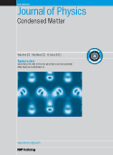
JOURNAL OF PHYSICS-CONDENSED MATTER
Advancing the Frontiers of Condensed Matter Physics.JOURNAL OF PHYSICS-CONDENSED MATTER, published by IOP Publishing Ltd, stands as a premier platform for the dissemination of impactful research in the fields of condensed matter physics and materials science. Since its inception in 1989, this journal has successfully bridged the gap between fundamental and applied research, delivering cutting-edge findings pertinent to both the academic community and industry professionals. Ranking in the Q2 category for both Condensed Matter Physics and Materials Science, it holds a respectable position within the scientific community, as evidenced by its Scopus rankings. With a commitment to fostering innovative research and promoting open dialogue, the journal offers a substantial collection of articles that contribute to the evolving landscape of materials science and physics. Researchers and students are encouraged to engage with the journal’s rich content, which not only enhances their academic pursuits but also plays a crucial role in advancing technologies based on solid-state materials.

Condensed Matter
Fostering Collaboration in Condensed Matter ResearchCondensed Matter is a leading open-access journal dedicated to the diverse and dynamic field of condensed matter physics, published by MDPI since 2016. With its base in Switzerland, the journal aims to present a platform for researchers and professionals to share innovative findings and advancements in areas such as electronic, optical, and magnetic materials. As of 2023, it is ranked in the Q3 category for both condensed matter physics and electronic, optical, and magnetic materials, a testament to its relevance and growth within the scientific community. Researchers will find valuable insights through its accessible format, fostering collaboration and knowledge dissemination within this interdisciplinary field. With a commitment to enhancing the global dialogue in condensed matter studies, Condensed Matter invites contributions that explore theoretical and experimental approaches, thus pushing the boundaries of understanding in this crucial area of science.
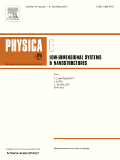
PHYSICA E-LOW-DIMENSIONAL SYSTEMS & NANOSTRUCTURES
Driving discoveries in the heart of material science.PHYSICA E-LOW-DIMENSIONAL SYSTEMS & NANOSTRUCTURES, published by ELSEVIER, is a premier journal dedicated to advancing the field of condensed matter and nanoscience, focusing on the innovative properties and applications of low-dimensional systems. With an esteemed Q2 ranking in multiple categories including Atomic and Molecular Physics, Condensed Matter Physics, and Nanoscience for 2023, this journal serves as a vital platform for researchers and professionals aiming to disseminate and discuss cutting-edge research. Established in 1974 and converging its focus from 1997 onwards, PHYSICA E captures the evolving landscape of material science, making it a crucial resource for anyone invested in the dynamics of electronic, optical, and magnetic materials. Although the journal operates on a subscription basis, its broad accessibility and significant placement within Scopus rankings—such as being in the 83rd percentile for Condensed Matter Physics—underscore its importance within the academic community. Researchers and students alike will find this journal a cornerstone for fostering knowledge and collaboration in the fields of nanotechnology and low-dimensional physics.

Transactions on Electrical and Electronic Materials
Unveiling Insights in the World of Advanced MaterialsTransactions on Electrical and Electronic Materials, published by Springer, is a distinguished journal aimed at advancing the fields of electrical and electronic engineering, as well as electronic, optical, and magnetic materials. With an ISSN of 1229-7607 and an E-ISSN of 2092-7592, this journal is vital in disseminating impactful research and innovations, providing insights and significant findings that cater to both academia and industry. Holding a Q3 ranking in the categories of Electrical and Electronic Engineering and Electronic, Optical and Magnetic Materials, it serves as a reputable platform for sharing research that influences ongoing developments in these critical areas. The journal's converged years from 2011 to 2024 signify its commitment to providing a comprehensive review of technological advancements. Located in New York City, it appeals to a global audience of researchers, professionals, and students, enhancing their understanding of current trends and practices within the domain.

Magnetohydrodynamics
Unlocking Insights in Magnetohydrodynamics Since 1970Magnetohydrodynamics, published by the University of Latvia Institute of Physics, stands as a crucial repository of knowledge within the realms of Electrical and Electronic Engineering and Physics and Astronomy. With its roots extending back to 1970, this journal offers an extensive archive of scholarly articles focusing on the dynamics of electrically conducting fluids, an area of increasing relevance in both theoretical and applied physics. Although the journal currently does not operate under an open-access model, it provides valuable insights that continue to impact ongoing research and technological advancements in magnetohydrodynamic applications. Its prestigious standing is reflected in its Q3 category rankings within both specified fields and its significant position within the Scopus rankings, marking its importance for professionals and researchers alike. As the journal reaches the convergence years culminating in 2024, readers can expect a rich anthology of pioneering studies and developments that bridge the gap between fundamental research and its practical implications.

APPLIED MAGNETIC RESONANCE
Advancing Knowledge in Atomic and Molecular PhysicsApplied Magnetic Resonance, published by Springer Wien, stands as a pivotal academic journal within the realm of Atomic and Molecular Physics and Optics. Established in 1990, this journal has become a prominent platform for disseminating high-quality research papers that explore innovative applications of magnetic resonance technologies. With its ISSN 0937-9347 and E-ISSN 1613-7507, the journal is recognized for fostering a deeper understanding of the theoretical and practical aspects of magnetic resonance across various scientific fields. Despite its Q3 ranking in the 2023 Scopus category, it continues to attract a diverse readership interested in advancing the frontiers of physics. Researchers and professionals are encouraged to contribute their findings, as the journal not only enriches academic discussion but also influences real-world applications, making it an essential resource for burgeoning scientists and seasoned experts alike. Additionally, while the journal is not open access, its comprehensive articles can significantly enhance scholarly knowledge and inspire further research in this vital discipline.

Lithuanian Journal of Physics
Advancing the Frontiers of Physics and AstronomyWelcome to the Lithuanian Journal of Physics, an esteemed publication helmed by the Lithuanian Physical Society, dedicated to advancing the field of physics and astronomy. Established in 2008 and continually publishing insightful research through 2024, this journal aims to provide a platform for high-quality scholarly articles that contribute to the understanding of various physical phenomena. With a steady presence in the academic landscape, the journal is currently ranked in the fourth quartile of the Physics and Astronomy category and is positioned at the 18th percentile in its Scopus ranking, reflecting its niche focus and accessibility for researchers and students alike. Although currently not operating under an open access model, the journal remains a vital resource for professionals seeking to stay informed on the latest developments in the field. The Lithuanian Journal of Physics invites contributions that inspire collaboration and innovation in physical sciences, making it an invaluable resource for the global scientific community seeking to expand knowledge within this dynamic field.
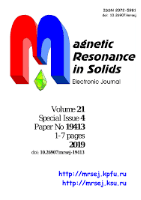
Magnetic Resonance in Solids
Bridging Disciplines in Nuclear and High Energy PhysicsMagnetic Resonance in Solids is a pioneering open-access journal, published by Kazan Federal University in the Russian Federation since 2006. With an ISSN of 2072-5981, this journal focuses on a diverse array of disciplines within Atomic and Molecular Physics, Electronic, Optical and Magnetic Materials, Nuclear and High Energy Physics, and Spectroscopy. Although its impact factor currently places it in the fourth quartile across multiple categories, the journal provides invaluable insights into the evolving field of magnetic resonance, informing researchers and professionals alike. It features a wide range of original research articles, review papers, and technical notes that foster the exchange of knowledge in solid materials characterization through magnetic resonance techniques. Despite facing competitive rankings, its open-access nature ensures broad dissemination of critical findings, appealing to a global audience of scientists, academics, and students seeking to advance their understanding of solid-state phenomena. The journal is continuously committed to promoting high-quality research and fostering innovation in its areas of study.
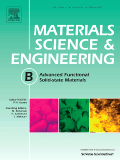
Materials Science and Engineering B-Advanced Functional Solid-State Materials
Advancing the Future of Solid-State MaterialsMaterials Science and Engineering B: Advanced Functional Solid-State Materials, published by Elsevier, stands as a pivotal platform in the realm of materials science, focusing on the development and characterization of advanced solid-state materials. With an ISSN of 0921-5107 and E-ISSN of 1873-4944, this journal operates out of the United Kingdom and addresses critical issues in condensed matter physics, mechanical engineering, and mechanics of materials. Its consistent recognition, evident in its Q2 quartile rankings across multiple engineering and physics categories and a respectable scope of convergence from 1988 to 2024, signifies its substantial contribution to the field. Researchers and professionals seeking a venue for cutting-edge work will appreciate the journal's commitment to advancing knowledge in functional materials, with its open access features ensuring that innovative findings are readily accessible. Join a community of leading scholars engaging with the latest advancements, shaping the future of materials science.
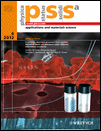
PHYSICA STATUS SOLIDI A-APPLICATIONS AND MATERIALS SCIENCE
Pioneering research in applications and materials science.PHYSICA STATUS SOLIDI A-APPLICATIONS AND MATERIALS SCIENCE, published by WILEY-V C H VERLAG GMBH, stands as a prominent journal in the fields of condensed matter physics, materials science, and engineering. With an ISSN of 1862-6300 and E-ISSN 1862-6319, this journal has been actively contributing to scientific discourse since its inception. The journal currently holds a respectable Q2 ranking across several categories including Electrical and Electronic Engineering and Materials Chemistry, demonstrating its significance in advancing research and development within these domains. Although it does not offer open access, the journal ensures high-quality peer-reviewed content that is critical for researchers and professionals aiming to stay at the forefront of materials science innovations. The journal’s convergence years, extending from 2005 to 2024, reflects its ongoing commitment to publishing impactful research. By facilitating discussions on applications and advances in materials science, PHYSICA STATUS SOLIDI A continues to be an essential resource for those striving to contribute to this dynamic field.